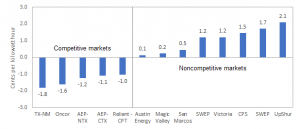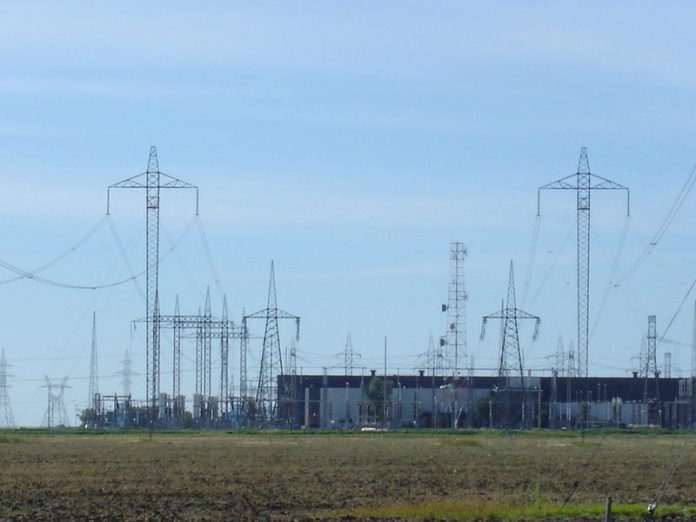By Thomas L. Hogan
The deregulation of the Electric Reliability Council of Texas (ERCOT) region has been held up as a model for electrical utility reform. As economist Jay Zarnikau describes, ERCOT “is generally considered to be the most successful of the restructured retail electricity markets in North America.” Yet recent weather-induced blackouts and anticipated price increases are causing many to question whether deregulation has benefited Texas consumers.
In a recent Wall Street Journal article, Tom McGinty and Scott Patterson argue that deregulation of electricity markets in Texas has resulted in higher prices. Since average prices were higher in competitive regions, the authors conclude that residential customers in deregulated markets “paid more for electricity than state residents who are served by traditional utilities.”
Unfortunately, this conclusion is highly misleading since the authors do not consider changes in electricity prices over time, nonresidential prices, or differences in costs of production.
The Texas state congress passed legislation in 1995 and 1999 to allow greater competition in the ERCOT region. Electric providers were given the choice to either open their local markets to competition or remain as municipal utilities. Consumers in competitive regions were allowed to choose their own electricity providers beginning in 2002. A set of transitional guidelines was established and then phased out by 2005.
What has happened to retail market prices since that time? Economists Peter Hartley, Kenneth Medlock, and Olivera Jankovska address this question in a 2019 article in the journal Energy Economics. They study electricity prices in Texas from 2002 through 2016. The authors find that prices in competitive markets declined over the period and became more closely related to the costs of production, while prices in noncompetitive markets did not.
Figure 1 shows the changes in average electricity prices in the thirteen Texas regions from 2002 to 2016. Since deregulation began, average prices have fallen in every competitive market. They have increased in every noncompetitive market.
Figure 1: Changes in average electricity prices, 2002-2016

Source: Harley, Medlock, and Jankovska (2019, p.7, table 1)
This pattern can be seen in the data used by McGinty and Patterson. From 2004 through 2019, their charts show that average prices in competitive markets were higher than those of traditional utilities but that the difference has declined over time. The premium peaked in 2006 and fell through 2017, although the gap has widened since.
McGinty and Patterson cite this premium as evidence that competition has caused higher prices. However, it actually shows the opposite. It shows that the regions that later became competitive markets had high historical prices back in 2004, before competition was fully allowed.
What caused prices to be higher in those regions? For starters, they may have higher costs of production. One example is the regional difference in employee wages. Another is the wholesale price of electricity, the price at which a power company can buy electricity rather than producing itself. The increase in competitive retail prices from 2002 to the peak in 2006 appears to be strongly related to the increase in wholesale prices over the same period.
Using econometric analysis, Hartley, Medlock, and Jankovska control for cost-related factors such as regional wages and wholesale prices. They find that these factors are important determinants of electricity prices in competitive markets but not in noncompetitive markets. This evidence is consistent with the theory that high prices in 2004 were caused by production costs and were not related to deregulation.
Accounting for these factors, the authors find statistically significant decreases in electricity prices in all five competitive markets after 2007. In noncompetitive regions, prices decreased in only one of the eight, were not statistically affected in four regions, and increased in three regions. The evidence shows that deregulation has reduced prices in competitive markets, while prices in noncompetitive markets are mostly the same or higher.
Focusing on residential prices, McGinty and Patterson also claim that over the period from 2004 through 2019, average competitive prices in Texas were higher than the national average. Again, this statistic is misleading due to the long time period, which includes years before competition became effective, and ignores the decline in prices over time. Yes, competitive residential prices in Texas were above the national average in the early 2000s. But they have now been below the national average for more than a decade.
In addition, McGinty and Patterson ignore commercial prices, which, like residential prices, have declined due to deregulation. Commercial electricity prices in Texas have been lower in competitive than noncompetitive markets since 2010 and below the national average since 2009.
Contrary to McGinty and Patterson, a close look at the evidence reveals that deregulation and competition have, in fact, reduced electricity prices in Texas. Prices in competitive markets have fallen, while those of noncompetitive utilities have increased. Competition has brought both residential and commercial prices down below the national averages.
Thomas L. Hogan, Ph.D., is a senior research fellow at AIER. He was formerly the chief economist for the U.S. Senate Committee on Banking, Housing and Urban Affairs. His primary research interests include banking regulation and monetary policy.
This article was originally published by the American Institute for Economic Research and is reprinted with permission.


























